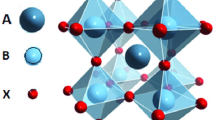Abstract
A novel route for obtaining iridium-based electrocatalysts supported on sub-stoichiometric titanium oxides for catalytic applications is presented. Chloride-free titanium oxide nanoparticles have been produced in a H2/O2-flame reactor using titanium (IV) tetraisopropoxide as precursor material. Fuel rich combustion leads to the formation of sub-stoichiometric titania (TiO2−x) with an increased number of oxygen vacancies and enhanced electrical conductivity. Subsequently, TiO2−x was dispersed in 2-propanol and spray coated on titanium substrate under argon atmosphere, forming a titania layer. This multilayered support system was decorated with iridium nanoparticles from an iridium-based electrolyte, applying an electrochemical method. This deposition technique leads to an optimized allocation of the electrocatalyst particles, adequate adhesion to the support and, furthermore, ensures the electrical conductivity from the deposited Ir particles via the TiO2−x coating towards the titanium substrate. Finally, this process generated electrochemically active electrodes for the oxygen evolution reaction (OER) in acidic environment. The mean crystallite size of the iridium catalyst was determined from the X-ray diffraction patterns according to the Debye–Scherrer equation to be 11.4 nm. Linear and cyclic voltammetry were performed in 0.5 M H2SO4 on the iridium/titania/titanium samples and proved the electrochemical activity of the prepared system. The increased catalytic activity of the prepared iridium samples was indicated by a decrease of the Tafel slope for the Ti-PTL/TiO2−x/Ir in comparison to electrochemically oxidized iridium sample. At higher overpotentials, the calculated Tafel slopes (112 mV dec−1) present greater values than commonly reported Tafel slopes for IrO2 based electrodes, revealing a different rate determining step for the OER.










Similar content being viewed by others
References
Wang L, Lettenmeier P et al (2016) Phys Chem Chem Phys 18:4487–4495
Ma L, Sui S, Zhai Y (2008) J Power Sources 177:470–477
Song Y, Yang J, Gong X (2015) Top Catal 58:675–681
Streibel V, Hävecker M et al (2018) Top Catal 61:2064–2084
Noack C, Burggraf F et al (2015) Studie über die Planung einer Demonstrationsanlage zur Wasserstoff-Kraftstoffgewinnung durch Elektrolyse mit Zwischenspeicherung in Salzkavernen unter Druck. Deutsches Zentrum für Luft- und Raumfahrt, Stuttgart
Man S, Su H et al (2011) ChemCatChem 3:1159–1165
Wang L, Song F et al (2017) J Mater Chem A 5:3172–3178
Rice R, Keptner D (2004) Appl Catal 262:233–239
Song S, Zhang H et al (2008) Hydrog Energy 33:4955–4961
Lettenmeier P, Wang L et al (2016) Angew Chem 128:752–756
Juodkazyte J, Sebeka B et al (2005) Electroanal 17:947–952
Liu C, Carmo M et al (2018) Electrochem Commun 97:96–99
Vot S, Roué L, Bélanger D (2012) Electrochim Acta 59:49–56
Toledo-Antonio J, Angeles-Chavez C et al (2016) Top Catal 59:366–377
Sharma S, Pollet B (2012) J Power Sources 208:96–119
Leichtweiss T, Henning R et al (2014) J Mater Chem A 2:6631–6640
Arif A, Balgis R et al (2017) Sci Rep 7:3646–3654
Näther J, Köster F et al (2017) IOP Conf Ser: Mater Sci Eng 181:012041
Antolini E (2014) ACS Catal 4:1426–1440
Abidov A, Allabergenov B et al (2013) Int J Mater Mech Manufact 1:294–296
Pan X, Yang MQ et al (2013) Nanoscale 5:3601–3614
Freakley SJ, Ruiz-Esquius J et al (2017) Surf Interface Anal 49:794–799
Siracusano S, Baglio V et al (2017) J Power Sources 366:105–114
Siracusano S, Baglio V et al (2009) Electrochim Acta 54:6292–6299
Geiger S, Kasian O et al (2016) J Electrochem Soc 163:3121–3138
Cherevko S, Geiger S et al (2016) J Electroanal Chem 773:69–78
Burke L, Naser N, Ahern B (2007) J Solid State Electrochem 11:655–666
Lettenmeier P, Majchel J et al (2018) Chem Sci 9:3570–3579
Acknowledgements
The present work has been carried out under the scope of the project “Entwicklung von kostengünstigen und nachhaltigen Elektrodensystemen auf Basis von optimierten Iridium/Titanoxid-Schichten für den Einsatz in der PEM-Wasserelektrolyse”. The IGF project (19817 N) of the research association (Umwelttechnik) was approved by the AiF within the framework of the program for the promotion of industrial community research and development (IGF) by the Federal Ministry of Economics and Technology Funded by the German Bundestag. Furthermore, we thank GKN Sinter Metals Filters GmbH, Germany, for manufacturing the Ti-based electrode structures, which were used as support material for our study and RUBION Center from Ruhr-University Bochum for accomplishing the XPS Analyses.
Author information
Authors and Affiliations
Corresponding author
Additional information
Publisher's Note
Springer Nature remains neutral with regard to jurisdictional claims in published maps and institutional affiliations.
Rights and permissions
About this article
Cite this article
Muntean, R., Pascal, D.T., Rost, U. et al. Investigation of Iridium Nanoparticles Supported on Sub-stoichiometric Titanium Oxides as Anodic Electrocatalysts in PEM Electrolysis. Part I.: Synthesis and Characterization. Top Catal 62, 429–438 (2019). https://doi.org/10.1007/s11244-019-01164-3
Published:
Issue Date:
DOI: https://doi.org/10.1007/s11244-019-01164-3




